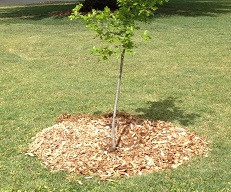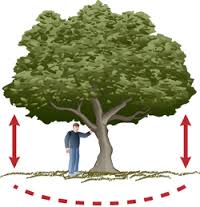Trees are vital. As the biggest plants on the planet, they give us oxygen, store carbon, stabilize the soil, muffle noise pollution, slow storm water runoff, and give life to the world’s wildlife. They also provide us with the materials for tools and shelter and increase property value.
As the drought continues, our urban forest is in need of extra care. Here are some simple ways to care for your trees while saving water.
Know Your Watering Rules
Each city and county has different rules for outdoor watering. Be sure you know which days of the week you can water your trees.
Add Mulch Around Your Trees
Wood chip mulch is one of the best ways to save water and can keep your trees healthy. A thick layer of mulch will keep moisture in the soil and protect the roots from extreme heat, so you use less water and your trees stay happy!
Learn more about how to mulch and where you can get free mulch for your trees!
Check the Soil
Some trees will need to be watered more often than others. How do you know if it’s time to water your tree? Check the soil!
Use a small shovel or screw driver to check the soil 6-8 inches below the surface.
If the soil feels dry and crumbly, it’s time to water your tree with a slow soak. If the soil feels sticky or wet, let it dry for a couple days before checking it again.
Water Responsibly With a Slow Soak
You want water to reach the roots of your tree, so water needs to slowly soak into the soil to reach the roots 12-18 inches below the surface. Because roots extend as a tree grows, young trees and mature trees need different watering techniques.
Watering Mature Trees
The roots of a mature tree extend underground even wider than the branches extend above ground. Use a soaker hose spiraled under the drip line of your tree (the soil beneath the edge of the leaves) or an oscillating sprinkler on a low setting to slowly soak as much of the root zone as possible. Allow the water to slowly drip into the soil for several hours.
These methods prevent unnecessary water runoff and provide the necessary water directly to the tree’s roots.
Learn more about caring for your mature trees.
**Native trees like the valley oak which have never received regular irrigation are specially adapted to our climate. Adding new water to naturally grown native trees can cause them harm. If you have questions about your large, native trees or concern about the health of any tree, contact a Certified Arborist to assess your specific situation and individual tree needs.


